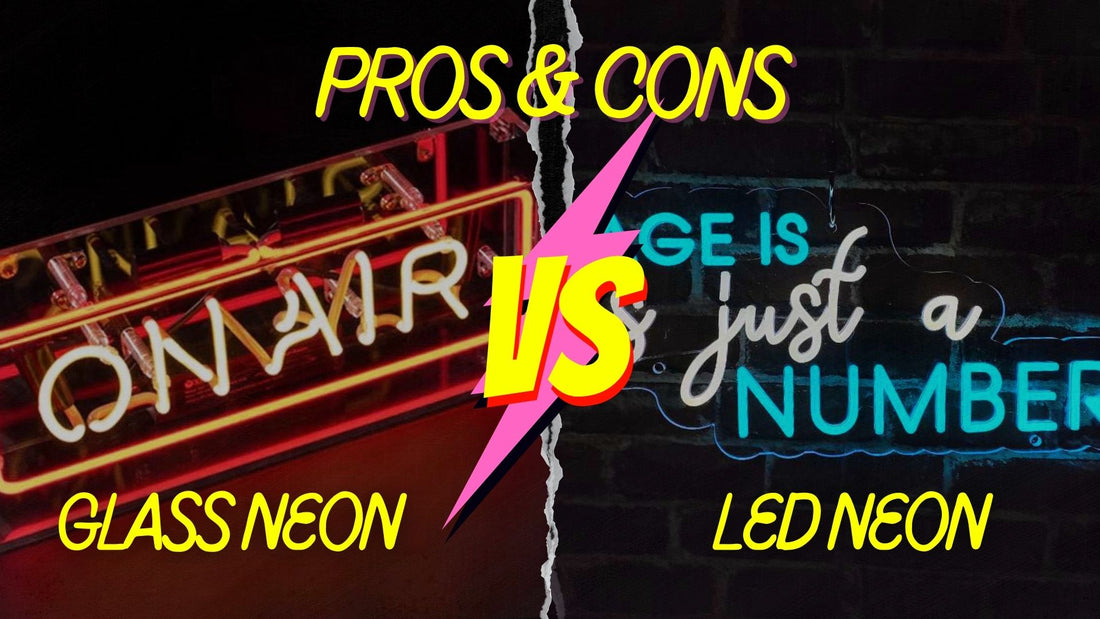Since LED neon signs have become widespread in recent years, there has always been the question of how they compare to traditional neon signs. The most common questions we hear are: Are glass neon or LED neon signs the best? What are the differences between LED neon and glass neon? What are the pros and cons of each? Which type of neon signage should I choose?
I wanted to write this article to compare the two and determine which wins.
- LED neon signs are brighter, safer, cheaper, and more energy-efficient.
- Traditional neon signs are fragile, expensive, and require more power.
- LED neon signs are superior in (almost) every aspect when compared to traditional neon signs.
- The only reason to consider buying a traditional neon sign is for nostalgic reasons.
Let's dive into my analysis of the ultimate lighting showdown - glass neon vs LED neon signs.
Glass Neon vs LED Neon Signs - Infographic

What are the key differences between LED neon and glass neon signs?
Here is a summary of the differences between the two types of neon signs.
LED Neon Signs are:
- Made from LEDs (light emitting diodes).
- Affordable to buy.
- It is made of hardened flame-retardant plastic, which is also shatter-resistant.
- Convert 95% of electrical current to light. Power consumption is 1800 watts of power.
- Light and easy to hang on drywall, like a picture.
- A lifespan of 80,000 hours of use.
- Lack the vintage look of traditional neon signs.
- Silent operation.
- Ultra bright and dimmable.
- Available in 24 colors of LED.
- Programmable and multi-color options.
- Produce no heat, use no gases, and don't need toxic chemicals.

Glass Neon Signs are:
- Expensive to buy.
- Made with fragile glass tubes.
- Convert 20% of electrical current to light. Power consumption is 4800 watts of power.
- It requires multiple people, including an electrician, to install it.
- A lifespan of 10,000 hours of use.
- Need professional maintenance every month.
- Have an authentic look from the 1950s.
- Make a constant buzzing noise.
- Produce more light pollution, with less focussed lighting.
- Fewer than ten color options.
- It gets scorching hot and will burn the skin. It uses a rare neon gas and mercury, which is very dangerous.

LED vs Neon - Which wins?
It's reasonably clear that LED neon wins in almost all aspects that anyone would consider. The only element that traditional glass neon signs might win on is that, for some people, they hold a sense of history and nostalgia.
I hope this in-depth comparison has been super-helpful for our customers and readers.
We only make our products and neon signs with LED neon - we embrace the future, which means LED lighting.
If you want to discuss a neon sign project and get a free design and quote, please contact one of our team members using our custom quote form.
Glass Neon vs LED Neon FAQ
What are glass neon signs?
Glass neon signs are made using glass tubing, which is molded and shaped into a design. The glass tubes are filled with various gases (neon, xenon, mercury, krypton, and argon gas), and when an electric current is passed through the tube, the neon gas inside glows with color.
What are LED neon signs?
LED neon signs are made using LED neon flex, which is plastic tubing filled with LED lights. LED neon flex can be molded and shaped into a design. LEDs (light-emitting diodes) are energy efficient and require low power. They produce very little heat, require no maintenance, and are durable.
Which is better, out of LED and neon signs?
LED signs are better. They are cheaper to buy, easier to maintain, more energy-efficient, last longer, don't use toxic gases or substances, and can be molded into more shapes and designs.
What lasts longer, neon or LED?
Glass neon signs typically have 10,000 hours of use before needing replacement. LED neon signs typically have 80,000 hours of use before needing replacement - They last 8x longer.
How do you tell if a sign is neon or LED?
Traditional neon signs use glass tubes. They make a buzzing noise, and the glass tubing gets hot. There are three ways to tell a glass neon sign.
LED neon signs are cool to the touch and have a very even glow over the LED neon flex tubing. If the neon sign changes colors, this is evidence of an LED neon sign. LED neon signs are also thinner (viewed on the side), typically only 2" tall at most.
Is neon more expensive than LED?
Traditional glass neon signs are more expensive than LED signs. From our experience, for an equivalent design turned into a glass neon sign and an LED sign - the cost difference would be 4x the cost for the glass neon vs LED neon. In short - glass neon is 4x the price of LED neon.
Are LED signs as good as neon?
LED signs are superior to glass neon signs—they are cheaper, safer, more eco-friendly, have better energy efficiency, and use highly efficient LED neon lights. LED signs are the modern equivalent of traditional neon signs.
Which is better, neon light or LED light?
LED lights are brighter, cheaper to run, easier to maintain, and safer to be near.
Which is preferable for business signage?
LED neon signs are better for business signage. They can be molded into more complex designs to suit logos or graphics, they last longer, and they require less maintenance and use less power.
Which type of light-up sign is better for indoor wall art?
LED neon wall art is superior to any other form of light-up artwork. LED light-up signs are safe to be near, don't produce heat or make any noise, and are also brighter. They have programmable and dimming options, making them far more advanced and versatile than other signs.
Are glass neon or LED signs more portable?
LED signs are highly portable, lightweight, and can be used with battery packs. They are also brighter and safer, using only 12 volts of electricity.



